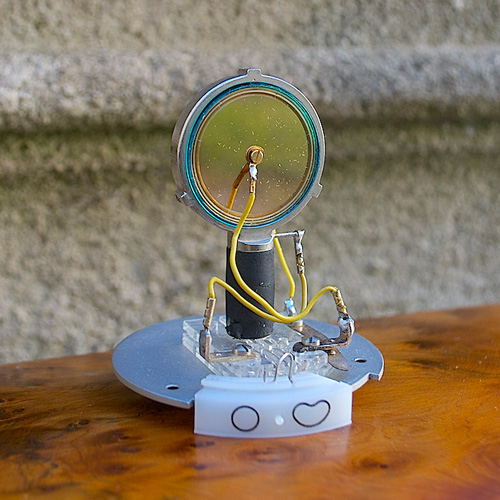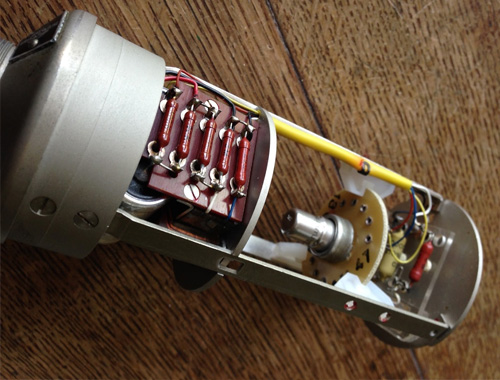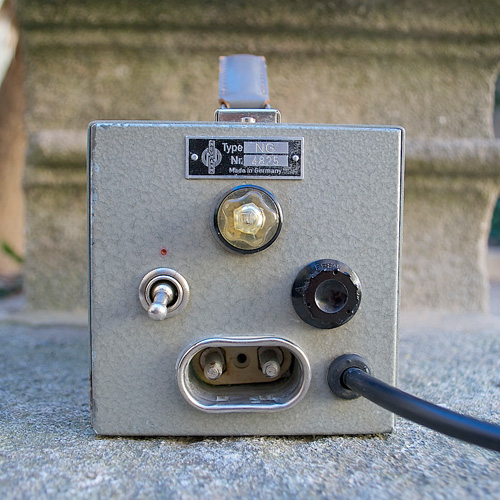It was the first post-war microphone from Georg Neumann’s West German company. And for many engineers and musicians, the Neumann U 47 still stands as a seemingly insurmountable peak of microphone design.
Remarkably simple by today’s “everything-must-do-everything” standards, the U 47 housed fewer than 20 electrical components – minus the power supply – in a simple tube circuit. It was the first commercially available microphone that could switch pickup patterns without physically changing the head of the mic, and its sound brought a hair-raising level of detail and nuance to recorded music that no one had experienced prior.
But what is that sound exactly? As a mentor of mine endlessly quipped, trying to read or write about sound (much less music as a whole) is a lot like dancing to explain architecture. Nonetheless, there is a world of objective analysis around the U 47’s tonal properties.
The U 47 has an enormously deep bass pickup that’s only accented as you move it closer to the sound source, which arguably made this microphone the gateway drug to close-micing – the technique that shaped the sound of all recordings after the U 47’s release.

The midrange has been described for decades by professionals as “authoritative,” able to put the human voice especially into the forefront of any recording with a charge and force that no equalization will ever achieve. It’s been theorized that the acoustical properties of the U 47’s head basket contribute to a certain high frequency lift that would situate a single track directly on top of everything else in the mix.
If this reads like the marketing copy for any and all contemporary microphones, that’s no accident. That’s the sound that everyone is going for. But the marketing copy for the Neumann U 47 was more along the lines of “Hey, look what we did. This is way better than what you already have. Really. Get this one.”
To give it a near-exact electric guitar analogy, the U 47 is the 1959 Gibson Les Paul “Burst” of the recording world. Fewer than 6000 were ever produced by the estimates of historians and technicians, and only a fraction of those still exist without serious modification or complete bastardization.
What could literally be pulled out of a dumpster 40 years ago or haggled from a radio station for stale bread now commands jaw-droppingly high prices on the vintage market, thanks to sheer scarcity and legend. There’s no denying it – an incredible U 47 will still make your hair stand up in a way that no other microphone can, just as the first engineers ever to hear one experienced.
Many of the U 47s that were used time and again on every important recording session from 1949 through today have seen intense levels of repair and modification. The legitimate “unplucked cherries” of the bunch fetch even more money, even though they probably never made a single record and almost definitely need a new capsule. They were adorned with both Neumann and Telefunken badges, being that Telefunken was Neumann’s distributor and supposedly a stakeholder and co-design firm for the U 47.
There are also outright fakes. Welcome to the vintage microphone market, I guess. Or the vintage anything market.
This buyer’s guide aims to educate potential vintage U 47 owners or curious onlookers of the benefits and pitfalls, the “oh yesses” and the “gotchas,” that come with shopping for a 60-year-old microphone that went through several revisions, that was on about 100 billion classic records and maybe 400 billion awful ones.
CAVEAT #1: The Capsule
Any microphone’s capsule is the proverbial ear in the room. This is the first point of transduction – that which turns mysterious, invisible moving sound waves into electricity that can be amplified and reproduced through a speaker. At once science and magic. Mostly magic, even.
The U 47’s original incarnation featured the fabled M7 capsule – a dual-sided element with PVC glued onto either side of the brass backplate. It was designed to perfectly skirt Western Electric’s existing patent while retaining a lot of the initial genetic makeup. Being that the Neumann M7 capsule was skinned on both sides, it could pick up sound from 360 degrees with a simple two-way switch for cardioid or omnidirectional pickup. Or, in the case of the U 48, bi-directional pickup in place of omni.

Reskinned M7 Capsule
The problem here is physics. PVC starts to harden, dry and crack nearly immediately. Even if an authentic, vintage replacement PVC M7 capsule were to be stored in its original plastic box for however many years, it would not spec out the same as the day it left the factory once you pulled it out and popped it into a microphone. The theoretical “New Old Stock” capsule has a way better chance of sounding the way it should…but that capsule is also theoretical.
The sonic result with this drying touches on both the low and high frequencies captured by the capsule. A dried, cracking M7 will sound notably lighter in the bottom octaves with a more gentle top-end response. The low-frequency waning over time was made up by very close vocal work, where proximity effect in cardioid mode kicked up the bass.
When the wear on the front side of the capsule got to be too much, studios and resellers started turning the capsules around, being that the rear of the capsule rarely saw the sort of use and abuse that the “business end” did. Keep in mind that these microphones were typically used for vocals and instruments and didn’t get switched over for omnidirectional/distant work very often.
Neumann noticed this particular issue early on and replaced the PVC M7 capsule with the Mylar-skinned K47 (also used in the M49 microphone, designated as K49 even though the actual capsule was essentially the same), which has proven to be superior with regards to consistency and stability. Sonically, the K47 capsule in the U 47 nods toward more forward and aggressive tendencies, whereas the earlier M7 capsules are more sweet and sultry. Subtle to the layman, but noticeable to the trained listener or anyone truly paying attention.

K47 Capsule
If you were to come across an M7-equipped example today, you could be all but guaranteed that it would require a trip to ex-Gefell employee Sigfried Thiersch to be reskinned. Being that reskinning a capsule is pretty much black magic at this point (and Mr. Thiersch has a waiting list), your other option is to put a brand new Neumann K47 capsule into the mic as they are remarkably consistent with the original capsules from the late 1950s.
Mr. Thiersch also manufactures his own M7 capsules in both PVC and PET (Polyethylene Terephthalate) versions, which can be identified by the color of the ring around the diaphragm – blue for the former and red for the latter. If you’re in the market for an M7-equipped mic, having a Thiersch capsule installed appears to keep the value of the microphone around the same as having a genuine K47 capsule.
Today, we’re at a point where an original M7 capsule should diminish the overall value of the U 47 by at least the cost of a new K47 and professional installation. Reskinned M7s should be done by an expert (of which there are maybe two in the world) and can retain original value if all else is the same.
Big “if.”
CAVEAT #2: The Tube
There’s a bit of folklore behind the U 47’s Telefunken VF14 tube and its origins. Was it a military tube that drove radio and long communication lines? Was it designed specifically for this particular microphone? I tend to believe the latter, especially because one of the most encyclopaedic minds in microphonium named Oliver Archut (RIP) says that’s the case. That, and there’s no documented mention of the tube before the microphone.
But hell, there may be merit to the former. Perhaps it started out as a prototype or drawings for underwater transmission or whatever-the-hell and then died on the vine, only to have Neumann commission Telefunken to finish the job and stick it into a mic.
Everyone who actually knows has passed on, and the rest of us are pullin’ at our chins in the dark. But one fact remains: a functioning VF14M (“M” for “microphone-grade” – standard VF14s that were either rejected during initial testing or were never tested also exist) is necessary for the sound and brow-raising value of the Neumann U 47.
This steel tube did but one job in the U 47: transform impedance. Seems simple enough, right?
Wrong. The VF14 in and of itself is something of an electronic marvel which will likely never be recreated. Specialized machinery was and is necessary for manufacturing steel vacuum tubes, with just the welding process requiring machines that would be financially out of reach of any modern day torch-holding dork to bring back to life.
In other words, it ain’t gonna happen.
After production and support for the VF14 was cut off (bombs destroyed most of the Telefunken tube factories), Neumann started retrofitting U 47s to use the cutting-edge “Nuvistor” – a long-lasting, smaller substitute but a technically gross mismatch to the rest of the circuit and especially the output transformer. Wave goodbye to the mythical bass response and bold midrange texture of the genuine artifact, a side effect that’s far more pronounced than that of an aging-but-good PVC M7 capsule.

“Nuvistor” Modified Mic
Modified microphones and new “inspired” microphones may also use EF12 and EF14 tubes in place of the original VF14M. None will complement the rest of the circuit the way that the VF14M does, even with necessary modifications for both the microphone itself and the power supply. Certain companies have even manufactured solid state drop-in replacements that do get pretty close, if all other things remain original. Again, big “if.”
The value of a U 47 relates to the tube in a couple of ways – if the supplied tube is original and simply needs replacement, then the price-drop goes straight toward a working VF14M tube. That’s $2,000-$3,000 as of this writing, but bank on getting at least one that is halfway to being dogshit before you get one that’s microphone-grade.
If the supplied tube is not a VF14 and the microphone has been converted for something else, then the value should drop according to the service required to bring the microphone back to original spec in addition to the monies required to snag a VF14.
And yes, there are counterfeit VF14 tubes and there are non-”M” tubes that are useless in a microphone which mysteriously got a white “M” painted onto them when dealers started getting frantic about the dwindling supply.
CAVEAT #3: “Long Body” vs. “Short Body”
This is only going to be a caveat as long as vintage mic dealers and collectors make it out to be a caveat. The physically longer microphones from the original production runs (until ~1958) went to shorter bodies for only one reason – the microphones could totally be shorter. The length of the body does not have any impact on the sound of the microphone.
Everything else makes a bigger difference. Some short body microphones were originally supplied with M7 capsules, and these microphones should be serviced and repaired just as any long body U 47 should be. Do not pay more money for a “long body” U 47 unless you hate money.
This same thing goes for head baskets to a large degree. The finish on the baskets changed at some point in the 1950s from chrome to matte nickel, but this only affects how they age physically and the amount of shiny-blingy-whatever that a singer can see. The dimensions remained the same and retained the same standing wave around the capsule that aids in giving the U 47 its signature presence.
CAVEAT #4: The Output Transformer
With the exception of the first couple hundred U 47s produced, these microphones use the Neumann BV8 output transformer. The earlier models used a vertically-oriented transformer with a slightly larger bobbin – some modern “clone” manufacturers use this earlier transformer type and swear by them.
In the end, so long as the transformer is original to the microphone, the exact model designation of the transformer or revision of the BV8 appears to have no effect on the market value of the microphone.
CAVEAT #5: The Power Supply and Calibration
An “all original” U 47 power supply would have capacitors that are almost 70 years old. Naturally, that will require service (replacement) if it’s not already been done. Another big thing to think about here is the adjustment and calibration of the power supply to safely and properly “feed” the tube. As the components in the PSU age, the steady climbing of B+ voltage will start to rear its ugly head and take your $2,000 tube into its jaws.

Power Supply
If you are not familiar with what “B+ voltage” is, you absolutely must not attempt to service the microphone or power supply yourself due to risk of fatality – both for you and for the microphone. When taking delivery of your new-to-you U 47, it is highly advisable to hand the microphone over to a respected technician with experience servicing these mics to make sure that the power supply is properly calibrated and everything is hunky dory.
Aftermarket power supplies are often seen with U 47s and all vintage tube mics. They are rarely of the same topology, and when we’re talking about any electronic circuit that’s so simple, swapping out the power supply will have dramatic effects on the sound of the microphone.
The Epilogue
Barring a miracle, the VF14M tube will never be produced again, and the world’s supply dwindles every single day. There will come a time when all existing U 47s will be without their original tube, and thanks to that, they’ll be without their signature tone, too.
So why own a U 47? Realistically, you can buy two great used cars for the same money, giving one to your kid and keeping one for yourself to schlep your numerous, less prohibitively expensive microphones from place to place. You can buy an entire mic locker for the price of one mint condition vintage 47.
In the case of commercial studios who own one or twenty 47s, keep in mind that many of these studios purchased these mics two or three decades ago when the price, while still high, was significantly easier to justify. And let’s face it, these studios take in a good chunk of change at their normal day rate, and just a couple weeks of sessions could totally pay for the price of a vintage Neumann U 47 or any other high-dollar microphone should they decide they need one.
For private studios, owning a U 47 is usually the result of an unshakeable fetish. People collect things, and the U 47 is highly collectable – simple as that. Could a Bock 47 or a Wunder CM7 or a Flea 47 get you 95% of the way there? Well, that just doesn’t seem to matter to some people. Only the genuine article will do.



